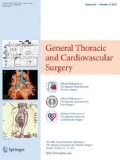Abstract
Objectives
The aim of this study was to determine whether walking at 4 h after surgery as a more aggressive way to proceed with early mobilization could be a safe approach compared with the patients who walked the day after surgery.
Methods
We encouraged patients who had lobectomy for non-small-cell lung cancer at Kansai Medical University Hospital to walk at 4 h after surgery and start pulmonary rehabilitation between January 2003 and June 2005. A group of 36 patients walked at 4 h after surgery. We retrospectively reviewed the postoperative courses of the patients and compared them with 50 patients who walked the next day during the same period.
Results
No patient had major trouble with chest drainage tube, and no patients fell when walking at 4 h. Amount of drainage, changing rates of the heart load during the walking, and pain scores after walking did not show significant differences in patients walking at 4 h and those walking the next day. Although four patients who walked the next day had an arterial oxygen partial pressure/inspired oxygen concentration ratio of <300 on day 3, none in the patients walking at 4 h had a ratio below this level. Among the patients walking at 4 h, 24 (67%) needed oxygenation for less than 2 days compared with 17 (34%) of the patients walking the next day.
Conclusion
Walking at 4 h after lobectomy in patients with non-small-cell lung cancers is a safe approach to starting pulmonary rehabilitation after surgery.
Similar content being viewed by others
References
K Korttila (1995) ArticleTitleRecovery from outpatient anaesthesia: factors affecting outcome Anaesthesia 50 IssueIDsuppl 22–8 Occurrence Handle7485913 Occurrence Handle10.1111/j.1365-2044.1995.tb06186.x
PF White I Smith (1994) ArticleTitleAmbulatory anesthesia: past, present, and future Int Anesthesiol Clin 32 1–16 Occurrence Handle7960169 Occurrence Handle10.1097/00004311-199432030-00003 Occurrence Handle1:STN:280:ByqD2cfotlQ%3D
VA Lawrence SG Hilsenbeck CD Mulrow R Dhanda J Sapp CP Page (1995) ArticleTitleIncidence and hospital stay for cardiac and pulmonary complications after abdominal surgery J Gen Intern Med 10 671–8 Occurrence Handle8770719 Occurrence Handle10.1007/BF02602761 Occurrence Handle1:STN:280:BymA28nlsVY%3D
JA Thomas JM McIntosh (1994) ArticleTitleAre incentive spirometry, intermittent positive pressure breathing, and deep breathing exercises effective in the prevention of postoperative pulmonary complications after upper abdominal surgery? A systematic overview and meta-analysis Phys Ther 74 3–10 Occurrence Handle8265725 Occurrence Handle1:STN:280:ByuD1cbotlE%3D
M Fagevik Olsen I Hahn S Nordgren H Lonroth K Lundholm (1997) ArticleTitleRandomized controlled trial of prophylactic chest physiotherapy in major abdominal surgery Br J Surg 84 1535–8 Occurrence Handle9393272 Occurrence Handle10.1111/j.1365-2168.1997.02828.x Occurrence Handle1:STN:280:DyaK1c%2FlsV2rsA%3D%3D
JC Hall R Tarala J Harris J Tapper K Christiansen (1991) ArticleTitleIncentive spirometry versus routine chest physiotherapy for prevention of pulmonary complications after abdominal surgery Lancet 337 953–6 Occurrence Handle1678039 Occurrence Handle10.1016/0140-6736(91)91580-N Occurrence Handle1:STN:280:By6A38rmvFI%3D
JC Hall RA Tarala J Tapper JL Hall (1996) ArticleTitlePrevention of respiratory complications after abdominal surgery: a randomised clinical trial BMJ 312 148–52 Occurrence Handle8563533 Occurrence Handle1:STN:280:BymC2M3gt1U%3D
BJ Noble GA Borg I Jacobs R Ceci P Kaiser (1983) ArticleTitleA category-ratio perceived exertion scale: relationship to blood and muscle lactates and heart rate Med Sci Sports Exerc 15 523–8 Occurrence Handle6656563 Occurrence Handle1:STN:280:BiuD1M3lsFE%3D
DJ Reinhart DR Grum J Berry D Lensch CR Marchbanks E Zsigmond (1997) ArticleTitleOutpatient general anesthesia: a comparison of a combination of midazolam plus propofol and propofol alone J Clin Anesth 9 130–7 Occurrence Handle9075038 Occurrence Handle10.1016/S0952-8180(97)00237-7 Occurrence Handle1:CAS:528:DyaK2sXisVeisrY%3D
Y Ding B Fredman PF White (1993) ArticleTitleRecovery following outpatient anesthesia: use of enflurane versus propofol J Clin Anesth 5 447–50 Occurrence Handle8123267 Occurrence Handle10.1016/0952-8180(93)90058-M Occurrence Handle1:STN:280:ByuC28fntlM%3D
Author information
Authors and Affiliations
Corresponding author
Rights and permissions
About this article
Cite this article
Kaneda, H., Saito, Y., Okamoto, M. et al. Early postoperative mobilization with walking at 4 hours after lobectomy in lung cancer patients. Gen Thorac Cardiovasc Surg 55, 493–498 (2007). https://doi.org/10.1007/s11748-007-0169-8
Received:
Accepted:
Published:
Issue Date:
DOI: https://doi.org/10.1007/s11748-007-0169-8




